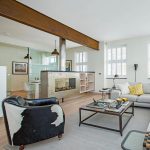Art Deco style has been captivating audiences since its emergence in the 1920s, characterized by its luxurious materials, bold geometrical shapes, and ornate embellishments. One of the most stunning ways to incorporate Art Deco into your home is by creating an Art Deco dining room. In this article, we will explore the key elements of an Art Deco dining room and how to incorporate them into your own space.
The Key Elements of Art Deco Style
Before diving into the specifics of creating an Art Deco dining room, it is crucial to understand the key elements of Art Deco style. These elements include:
- Geometric shapes and patterns
- Rich, luxurious materials such as velvet, lacquer, and metals such as brass and chrome
- Ornate embellishments such as inlays, etchings, and glasswork
- Streamlined, linear designs
- Strong color contrasts
Designing Your Art Deco Dining Room
Designing an Art Deco Dining Room starts with selecting a color scheme that often involves deep, rich colors like navy blue, emerald green, burgundy, and black. Although white is also used in Art Deco design, it’s often used as a canvas for showcasing the bold, rich tones that define the style. Your Art Deco Dining Room design should also focus on incorporating details such as black or white marble, chrome, and lacquer or velvet fabrics that will give the space an Art Deco vibe.
Furniture Selection
Furniture selection plays a significant role in designing an Art Deco Dining Room. Streamlined designs made from rich, quality materials like chrome, steel, and glass add to the glamour and sophistication of the era. Endowed with sharp geometric lines, the furniture features motifs like zig-zags, sunbursts, and chevrons expressed directly in the shapes of tables, chairs, sideboards, and dining benches. You could also incorporate luxurious accents like leather upholstery into your furniture.
Lighting
Lighting is often neglected but it plays a key role in designing an Art Deco Dining Room. Fixtures in Art Deco designs feature handcrafted artwork employing motifs and materials that reflect the glamour of the era. The use of geometric shapes and new materials like chrome, aluminium, and Bakelite creates strong lines and shapes that are both decorative and glare-free. Architectural elements like wall panels, ceiling coffers, and floors are incorporated into the design along with indirect and direct lighting, creating an atmosphere that’s at once luxurious, modern, and timeless.

